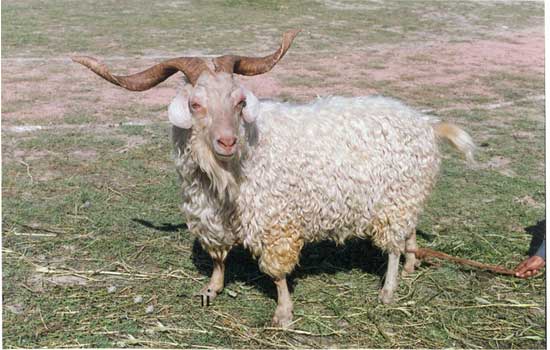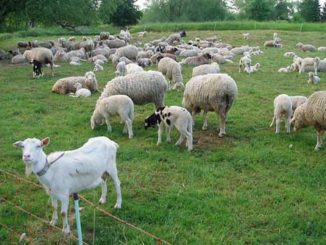Changthangi sheep is a native breed of Changthang region of Ladakh and is locally called as Changluk sheep. This sheep is mainly reared by a nomadic tribe called Changpa along with Pashmina producing Changthangi goat. Changpas are semi-nomadic tribal people found mainly in the Changthang in Ladakh of Jammu and Kashmir. The Changpas are always on the move with their animals. They mostly rear yak, Pashmina goats and Changluk sheep. Changluk sheep acts a a main source of income for this tribe. Shepherds of the Changpa tribe take the herds in the morning and roam the area far and wide, while whistling and singing, in search of good pastures and water. In the evening before the sun sets the shepherds bring the herd back home. The entire family is involved in taking care of the sheep and the herd.
Breed Description
Changthangi sheep is a medium size sheep with good fleece cover. The body of these sheep is covered with outer course hair covering called as guard hair, beneath which is a fine fiber coat. Average weight of adult ram ranges from 50-70 kg while that of ewes range from 35-50 kg. Majority of the animals have white colour. Other colours include a wide range of shades like black, brown, and grey, but white color dominants the herd population. The Ewes are very protective and attentive mothers resulting in high lamb survival rate. Both horned and polled animals are found in Changluk sheep. The tail is medium to short in length. The males were heavier than the females and superior in different body measurement traits. As per the latest census there are 1.50 lacs sheep in the district.

Utility of Breed
For many Changpas, rearing of animals, and consuming and selling their produce (milk and its products, hair and meat) is the only means of livelihood. Changthangi sheep is a multipurpose breed and is utilized for wool, fine wool, guard hair, pelt, meat, milk production and, dung energy. The breed is having two fleece coat; the outer course fiber and the fine inner coat, which protects the breed during harsh winters when temperature drops to – 40 degree Celsius. The fine wool is naturally grown on the sheep to protect it from the cold. At the beginning of summer season, in May, the local people comb the wool off the sheep with the help of a local comb specially designed for this purpose or do shearing during the months of may and June. The average wool production as observed was found to be 1.5 to 2 kg and is higher in male than female, out of which almost 700-800 grams of fine wool is produced. Almost every household is having 50-100 sheep. The wool is used for weaving of the woollen products. Each family is having sufficient raw wool and they do not need to procure it from any other source. But they have no market for raw wool, so they convert it into various woollen products by traditional methods. Most of the handloom in Changthang serve the need of the local people. For many it’s the main source of earning livelihood. Handloom weaving is one of the main activity of nomadic people of changthang of Ladakh region. Weaving becomes their chief occupational priority especially during harsh winter season. The weavers, especially women folk, follow their ancestral traditional methods for converting raw wool in to various woollen handloom products. viz: woollen shawls, gloves, caps, socks, choga, hand knit woolens, like woollen sweater, mafllars, rugs and blankets by spinning and weaving locally. These handloom products full fill their local needs, help them to improve their financial savings and thus empower themselves.
The Changpas also use the pelts as clothing as well as flooring material in their tents, which keeps their tents warm in the freezing temperature. They use the dung of this sheep as a source of fuel energy for cooking of foods and keeping their tent warm. They use milk of this sheep for making of salt tea. Buddhists usually do not slaughter or kill their animal but they do eat their meat when ever animal dies naturally or is killed by some predator.
Importance of breed
The breed is hardy and resistant to various diseases. This cold arid region of Ladakh experiences a very harsh winter. Therefore Changthangi sheep is the good source of meat and wool production in Leh especially during the lean period of winter. The farmers practicing this sort of farming earn a good amount of money from the adjoining areas where they sell their animals during the winter period especially in Leh town. Sheep farming is less labour intensive and is easy to establish in rural areas because of low input cost. These animals are disease resistant and disease management is not an issue in the traditional areas of the region. This breed possesses a special ability to thrive on natural grasses and do not need to be given any supplemented feed. They eat more different kinds of plants than any other kind of livestock. The production of meat, wool and manure by Changthangi sheep provide three different source of income per year to the farmers. This is important for the socio economic upliftment of the changpa tribes. Their dung is a valuable fertilizer, and since they graze on sub marginal lands, their droppings are the only means of improving the growth plants in such areas.
Conclusion
The reason for very low population of Changthangi sheep in the Union territory of Ladakh is that the breed is restricted to Changthang region of Ladakh only. Cold arid Leh region experiences a very harsh winter and remains totally cutoff from rest of the world because of the heavy accumulation of snow on various passes, which causes further rise in demand of meat during winter in Leh and thus further affect Changthangi population. The sheep is vital for economy for the changpa people of Changthang region. So these innocent animals should be treated ethically so as to maintain this breed. There is need for developing package of managemental practices, breeding plan and conservation initiatives for this unique sheep breed. . Keeping in view the potential benefits and its importance it has got a tremendous scope especially in rural areas of Leh during winters. There is also need to maintain this breed scientifically.





Be the first to comment